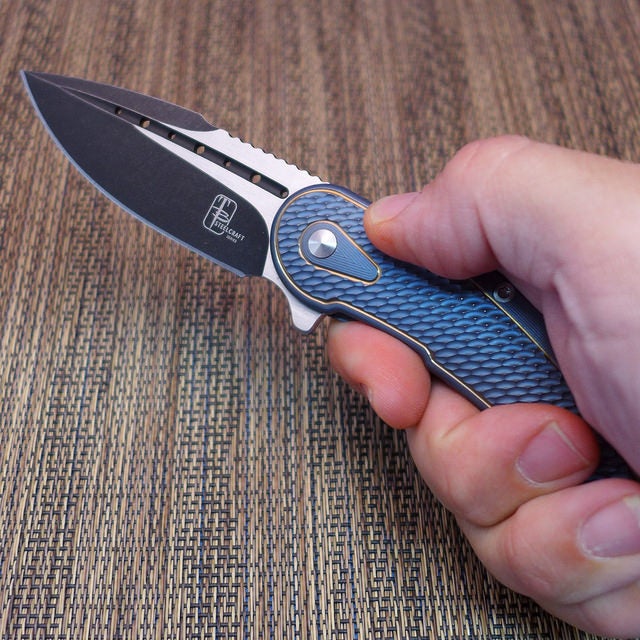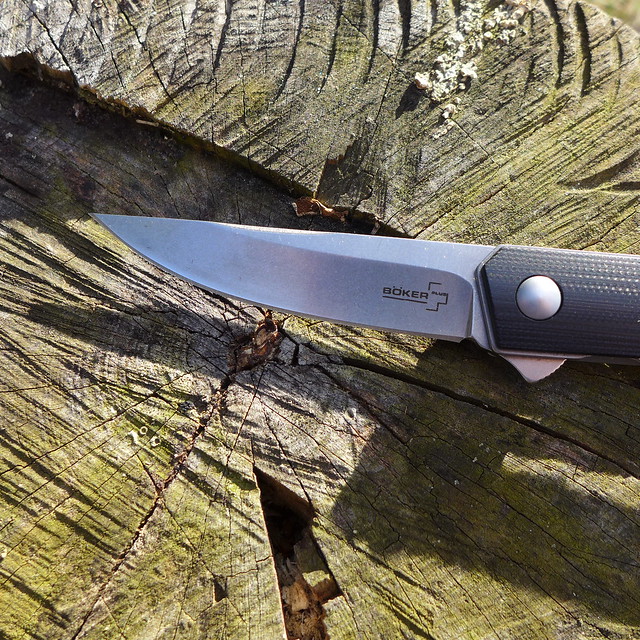The Flipper Tests, Part II
Tony Sculimbrene 04.20.18

Flippers are everywhere these days. Even Spyderco, a company based on a different deployment method, now has a line of flippers. The problem is flipper designs are exceptionally hard to do really well. Virtually every production flipper out there has some kind of issue. So before you plunk down some dough on a high end production knife or a custom flipper, see if it passes what I call the “Flipper Test.” Here are the last two criteria of the “Flipper Test” (this is Part II of a previous article, Part I can be found here):
Speed
Ideally a flipper will open just as a fast as any other kind of knife. The balance between the pivot and the detent and the shape of the flipper tab all impact speed. The best flippers open with a kinetic grace that is addicting. This is one of the reasons flippers have become so popular—its almost like a fidget toy. But there are real and practical reasons for a fast firing flipper.
First, it means that you are ready to respond quickly should the need arise. Second, you can open your knife discretely if it is fast. There is an obvious caveat to this—it needs to be both fast and quiet. Clacking open some massive beast isn’t discrete, but popping open a small flipper can let you get to your cutting task and have your knife back in your pocket before anyone even notices. In my experience the Boker Mini Kwaiken was perfect in this regard—it was small enough and discrete enough of a design to open and close before anyone noticed I had a knife.
It was a quick, quiet snap and I had a functional cutting edge and then one swift thumb motion and the knife was gone. Some people use their knives differently and want a fast but loud deployment. I have no tactical knife experience, so I will leave comments on that issue to someone else.
Functional Detent
One issue I have seen with flippers is that in an effort to get all of the things right—reliable deployment, speedy deployment, and no need for wrist action—the manufacturer really goes light on the detent. The end result is a good knife to flip, but a less than ideal knife to use and carry. Even some of the high end flippers on the market fail here. They are simply not tuned correctly. The problem with a weak detent is that over time you are more likely to bump your knife open on accident than you would be if you had a strong detent. Furthermore, in a lot of places, a weak detent could lead to problems with the law (this is not intended as legal advice, consult a lawyer in your area for legal advice). As such, a strong and functional detent is a very good thing on a flipper.
What you are looking for is a detent that is strong enough so that the knife cannot be shaken out of the handle when held in an ice pick grip. I usually grab the flipper at the end opposite the pivot with the blade spine facing out and shake and snap the knife. A large majority of flippers on the market will open up with a good stiff snap. The few that don’t usually do poorly in the other aspects of a good flipper.
Conclusions
Thus far, only a handful of knives have passed all five parts of the Flipper Test. The Massdrop x Ferrum Forge Gent, for example, passes all five parts of this test, including the strong detent. It is, as of early 2018, one of the best flippers on the market. Additionally, the Boker Mini Kwaiken (though not the large Kwaiken) passed all five parts of the Flipper Test. The Steelcraft Mini Bodega also passed all five parts.
A lot of “famous” flippers have not passed. The Shirogorov Neon I reviewed did not. It, like the Norseman I reviewed, did not past the Functional Detent test. Benchmade’s Axis flipper, the 300SN failed in just about every way possible. The Spyderco flippers had failed fire issues. Over and over again, knives just failed. Balancing the detent and pivot correctly on the massive scale required by production numbers is very hard. I have had a number of custom flippers and most of them did not pass all five parts either. The Getraitis Small Pathfinder did and all of the Gareth Bull knives I have owned did as well. My Laconico Jasmine, on the other hand, failed the Functional Detent part of the test.
In the end, flippers are easy to make and very, very hard to make well. If you get a chance to handle a flipper before you buy it, a few quick seconds running it through the Flipper Test can save you the agony of a bad purchase. It is also worth noting that production companies are always tuning their flippers. Spyderco announced a huge retooling at SHOT 2018 with their flipper line and my experience with the regular and small Kwaiken tells me Boker is doing the same, on a smaller scale. Something that doesn’t do well now, could do well in the future, so as always, be careful where you buy your knives and, if possible, handle them in person first.
Other flipper designs and flipper-like deployment
This test works on all flippers, but most people forget the front flipper design, something like the Gareth Bull Shamwari. Personally, I strongly prefer the front flipper as it always passes these tests. It is a bit more difficult to get the muscle memory up to speed, but once you do, a front flipper is a joy to use. It also has the added advantage of not marring the silhouette of the knife with a vestigal tail-like protuberance.
Additionally, a well-tuned thumbstud or thumb hole knife that uses a linerlock or a framelock can function as a flipper. With the KaBar Jarosz 7505, the knife’s detent and pivot were tuned so that even modest pressure on the thumbstud resulted in full deployment every time. The same is true, I have found, on the Ontario RAT folders. Likewise, my Spyderco Techno functions more like a flipper than a thumb hole knife thanks again to a good pivot and strong detent. If you want that snap open action, you might find it in a non-flipper knife.


